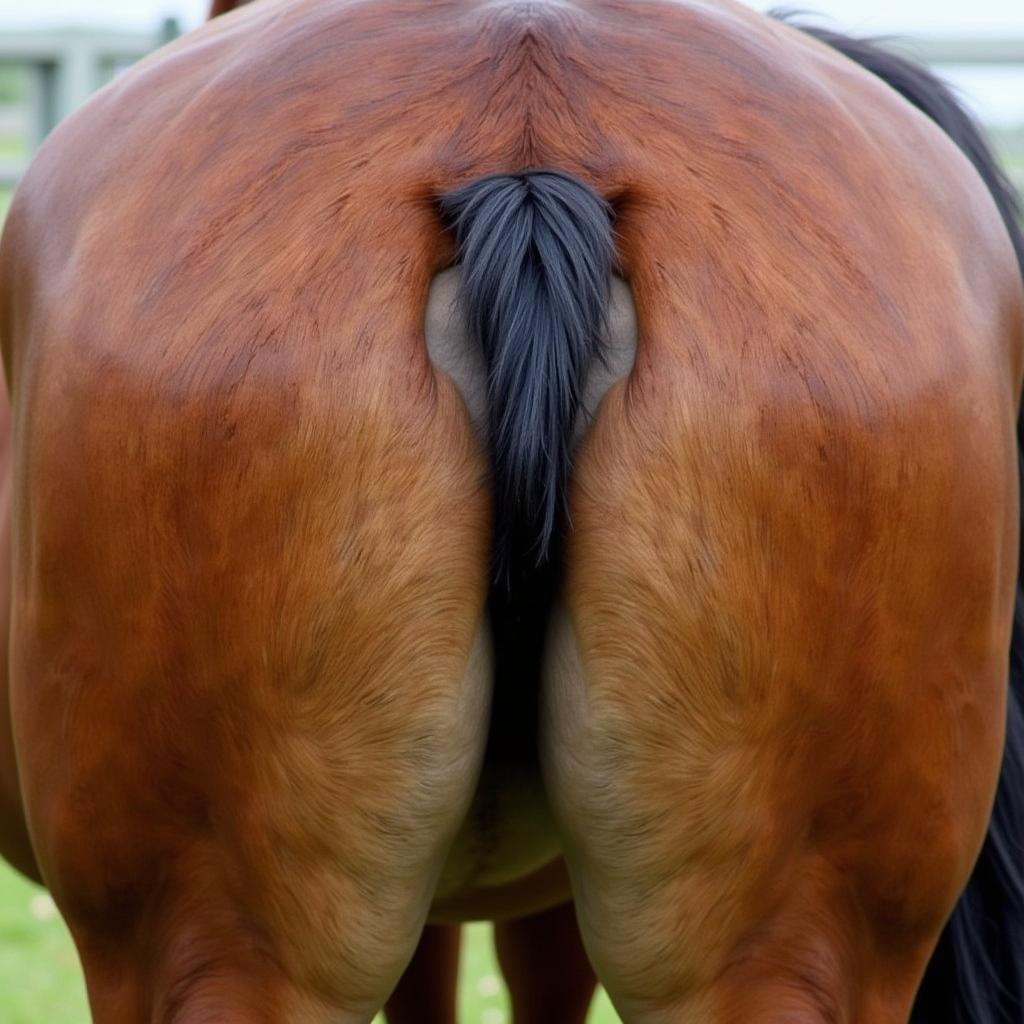The term “topline” in the equestrian world refers to the muscle groups that run along a horse’s back, from the poll (just behind the ears) to the croup (the top of the hindquarters). A well-developed topline is essential for a horse’s overall health, soundness, and athletic performance. A strong, supple topline allows the horse to move with ease and carry a rider comfortably.
 Horse with a Strong Topline
Horse with a Strong Topline
Factors Affecting a Horse’s Topline
Several factors contribute to the development and maintenance of a horse’s topline. These include:
- Age: Young horses are still developing their muscles, while older horses may experience muscle loss.
- Breed: Some breeds are naturally predisposed to having stronger toplines than others.
- Diet: A balanced diet with adequate protein and essential nutrients is crucial for muscle growth and repair.
- Exercise: Regular, appropriate exercise is essential for building and maintaining muscle mass.
- Saddle Fit: An ill-fitting saddle can cause pain and muscle atrophy.
- Riding Technique: A balanced and effective rider helps the horse engage their core and back muscles correctly.
Building a Better Topline: Exercises and Techniques
Developing a horse’s topline takes time, consistency, and a combination of correct training and care. Here are some effective exercises and techniques:
-
Stretching: Incorporate regular stretching routines into your horse’s warm-up and cool-down to improve flexibility and range of motion. Simple stretches like carrot stretches and tail pulls can be beneficial.
-
Long and Low Work: Encouraging your horse to work in a long and low frame, with their head slightly lowered and their back stretched, helps engage the abdominal muscles and strengthen the back.
-
Transitions: Regularly incorporating transitions between gaits—walk to trot, trot to canter, and back down—encourages the horse to use their back muscles for balance and impulsion.
-
Pole Work: Trotting poles and cavaletti exercises are excellent for building topline strength and coordination. They encourage the horse to lift their back and engage their core muscles.
-
Hill Work: Riding uphill requires the horse to use their hindquarters and back muscles for power, naturally building strength in the topline.
-
Proper Riding: A skilled rider who can maintain a balanced and independent seat allows the horse to move freely and correctly engage their muscles.
The Importance of Diet and Nutrition
A balanced and nutritious diet is paramount for building and maintaining a horse’s topline. Here’s what to consider:
- Protein: Adequate protein intake is crucial for muscle growth and repair. Look for high-quality protein sources in your horse’s feed.
- Amino Acids: Lysine and threonine are essential amino acids that play vital roles in muscle development.
- Fat: Fat is a concentrated source of energy that can be beneficial for horses in training. It also supports a healthy coat and improves overall condition.
- Vitamins and Minerals: Ensure your horse’s diet provides a balanced intake of vitamins and minerals, including Vitamin E and Selenium, which are antioxidants that support muscle health.
“A horse’s diet should be tailored to their individual needs, considering their age, workload, and any underlying health conditions,” says Dr. Emily Carter, equine nutritionist. “Consulting with an equine nutritionist can help you formulate a feeding plan that supports optimal muscle development and overall well-being.”
Recognizing Problems: Signs of a Weak Topline
Identifying signs of a weak topline early on is crucial for addressing any underlying issues and preventing further deterioration. Here’s what to look for:
- Dipping or Swayback: A noticeable dip or sway in the back, particularly when ridden.
- Difficulty Engaging Hindquarters: Struggling to bring their hind legs under their body and push off effectively.
- Poor Muscle Development: A lack of muscle definition along the back, with a prominent spine or ribs visible.
- Reluctance to Work: Showing resistance or discomfort when asked to perform certain exercises or movements.
- Change in Gait or Performance: A decline in performance, shortened stride, or unwillingness to move forward freely.
how to build topline on a horse
Conclusion
Building and maintaining a horse’s topline is a journey that requires dedication, knowledge, and a holistic approach. By focusing on proper exercise, a balanced diet, and attentive care, you can help your equine partner develop the strength, suppleness, and beauty of a well-defined topline.
Remember, a strong topline is not just about aesthetics; it’s a reflection of your horse’s overall health and well-being.
FAQs About Horse Toplines
Q: How long does it take to build a horse’s topline?
A: It can take several months to a year of consistent work and proper care to see significant improvements in a horse’s topline.
Q: Can any horse develop a strong topline?
A: While some breeds are genetically predisposed to stronger toplines, any horse, regardless of breed, can improve their topline with correct training and care.
Q: What should I do if I suspect my horse has a back problem?
A: If you notice any signs of a weak back or your horse shows signs of discomfort, consult with your veterinarian or an equine chiropractor immediately.
Need further assistance in building your horse’s topline? Contact us!
Our team of experts at Justus Horses USA is here to provide guidance and support.
Call us at: 0772127271
Email us at: [email protected]
Visit us at: QGM2+WX2, Vị Trung, Vị Thuỷ, Hậu Giang, Việt Nam
We have customer support available 24/7 to assist you.